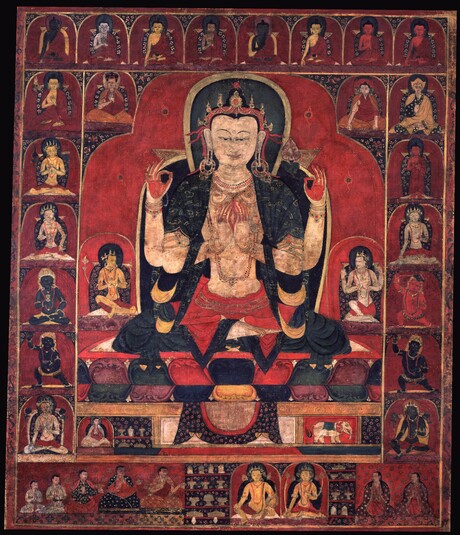
Item: Avalokiteshvara (Bodhisattva & Buddhist Deity) - Chaturbhuja (4 hands)
| Origin Location | Tibet |
|---|---|
| Date Range | 1400 - 1499 |
| Lineages | Karma (Kagyu) and Buddhist |
| Material | Ground Mineral Pigment on Cotton |
| Collection | Rubin Museum of Art |
| Catalogue # | acc. #C2002.8.1 |
Alternate Names: Lokeshvara Avalokita Lokanata Lokanatha Mahakarunika
Classification: Deity
Appearance: Peaceful
Gender: Male
Avalokiteshvara, Chaturbhuja (Tibetan: chen re zi, chag shi pa. English: the All Seeing Lord with Four Hands).
The central figure is Avalokiteshvara, white in colour, with four hands. At his right is the male attendant Manidharin, yellow in colour, and at the left, the female, Shadakshari, white in colour. Both are similar to the Lord in colour, ornaments and appearance. Sometimes they are referred to as the son and daughter of Avalokiteshvara. The iconography for the two attendant figures is not consistent nor is it necessarily fixed in one or another authoritative orthodox text. The two attendants can appear either white or yellow in colour and have either two arms or four. Sometimes Manidharin appears with two arms and Shadakshari with four.
"As the nature of all buddhas, Avalokiteshvara, in colour like stainless conch and crystal, very resplendent, smiling, peaceful and radiant. With four hands the first are folded at the heart, the lower hold a crystal mala and jeweled lotus, two beautiful feet seated in vajra posture, adorned with many attractive silks and jewels, beautified with dark blue hair in tufts [some] loose. On the crown of the head, the wisdom of all buddhas, is the Lord, source of all refuge gathered as one, in essence the Guru in the aspect of Amitabha [Buddha], in the manner of the Lord of the Family, seated happily." (Ngorchen Konchog Lhundrub 1497-1557).
Learn how to read a similar painting of the same subject (HAR #73807):
Analysis | Interpretation | Identification
Avalokiteshvara can be looked upon as the patron deity of Tibet. He is also included in all Himalayan and Tibetan Buddhist traditions as both a bodhisattva contained in the narrative stories of the Sutras and as a meditational deity - explained in the Tantra texts of the Vajrayana tradition. There are numerous New (Sarma) lineages and varying forms of practice that span all four tantric classifications as well as uncounted old oral traditions (Kama) and Treasure (Terma) traditions from the Nyingma School of Tibetan Buddhism.
There are many different sacred Buddhist traditions that depict the various forms of Avalokiteshvara. Most of these traditions only have an initiation ritual and at best a very short daily ritual practice (sadhana). Preserved in the Tibetan Buddhist tradition there are seven principal traditions that contain extensive teachings on the practice of Avalokiteshvara. The first of these is:
1] King's Tradition (gyal lug) of Tri Songtsen Gampo,
[2] Bhikshuni Shri Tradition (gelongma palmo lug) of the Kashmiri nun, Gelongma Palmo [top right corner],
[3] Kyergangpa Tradition (gyergang lug) of the Shangpa Kagyu,
[4] Tsembupa Tradition (tsembupa lug) of the Sakyas,
[5] Dagyal Tradition (dagyal lug) of the Nyingma Treasure (terma) tradition,
[6] Maitri Yogin,
[7] Karma Chagme Tradition (karma chagme lug) joining the philosophical systems of Mahamudra and Dzogchen with compassion.
Jeff Watt 10-2010
Numbered & Greyscale:
1. Chaturbhuja Avalokiteshvara
2. Manidharin
3. Shadakshari
4. Karmapa
5. Tibetan Teacher or Nagarjuna (?)
6. Tibetan Teacher
7. Medicine Buddha
8. Medicine Buddha (retinue)
9. Medicine Buddha (retinue)
10. Medicine Buddha (retinue)
11. Medicine Buddha (retinue)
12. Medicine Buddha (retinue)
13. Medicine Buddha (retinue)
14. Medicine Buddha (retinue)
15. Maitreya Buddha (?)
16. Padmasambhava (?)
17. Manjushri, Yellow
18. Amitabha Buddha, Red
19. Vajrasattva, White
20. Avalokiteshvara, White
21. Vajravidarana, Green
22. Hayagriva, Red
23. Vajrapani (or Mahakala)
24. Achala, Blue
25. Manjushri, Lokeshvara or Tara (?)
26. Tara, Green
27. Jambhala, Yellow
28. Vasudhara, Yellow
Male Donors on the viewer's left
Female Donors on the viewer's right
Reverse of Painting
Special Features: (Printed script (Uchen), includes "Om Ah Hum" inscription)
Buddhist Deity: Avalokiteshvara, Chaturbhuja (Without a Krishnasara)
Buddhist Deity: Avalokiteshvara Main Page
Collection of Rubin Museum of Art (RMA): Main Page
Buddhist Deity: Avalokiteshvara, Chaturbhuja - Four Hands - Main Page
Buddhist Deity: Avalokiteshvara, Chaturbhuja (Early Works)
Collection of Rubin Museum of Art: Avalokita (Painting)
Padmasambhava: Early Images (Primary & Secondary)
Buddhist Deity: Avalokiteshvara, Chaturbhuja (Three Deity)
Collection of Rubin Museum of Art: Avalokiteshvara Page (Painting Masterworks)



